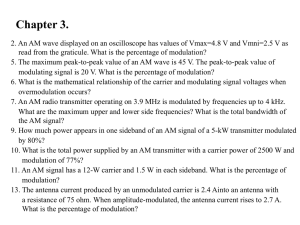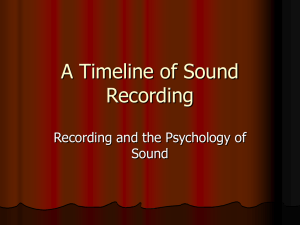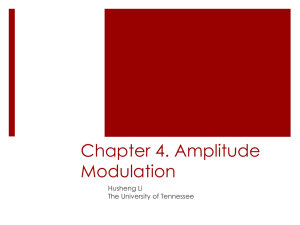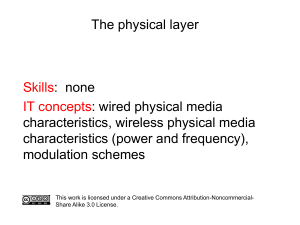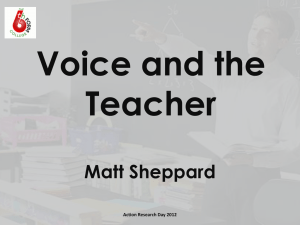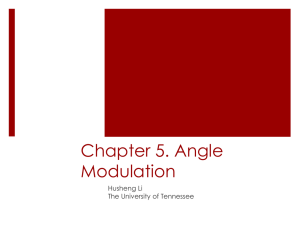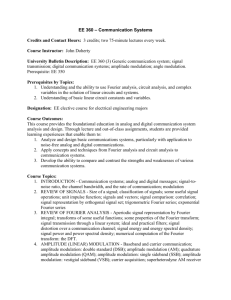CE-UNIT-I
advertisement
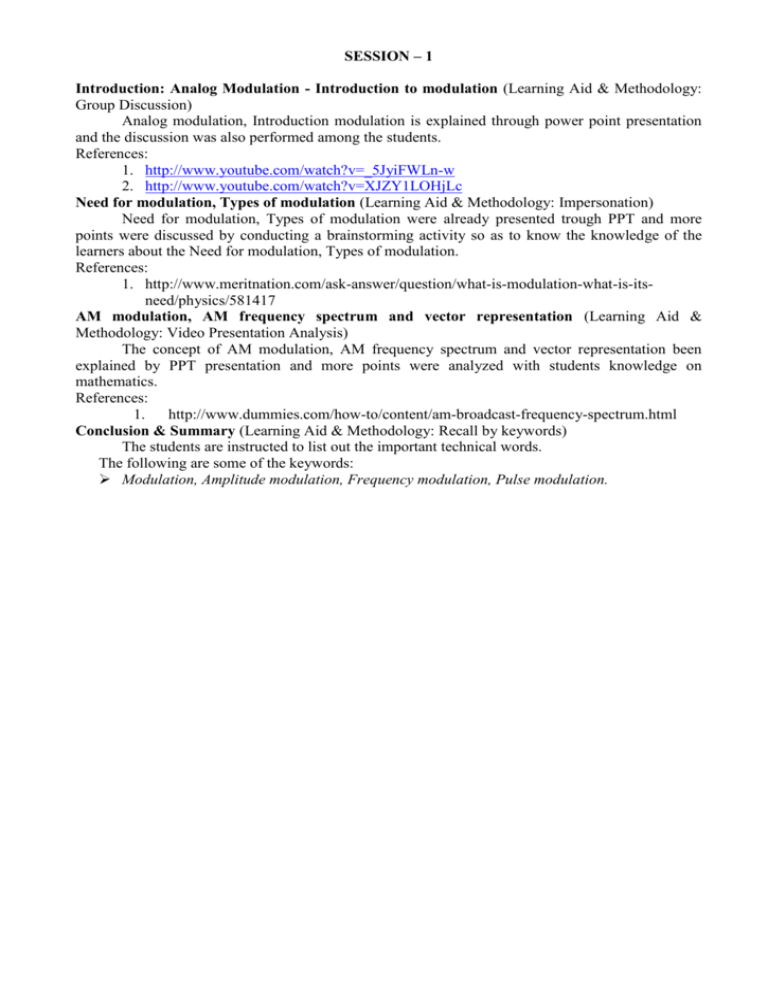
SESSION – 1 Introduction: Analog Modulation - Introduction to modulation (Learning Aid & Methodology: Group Discussion) Analog modulation, Introduction modulation is explained through power point presentation and the discussion was also performed among the students. References: 1. http://www.youtube.com/watch?v=_5JyiFWLn-w 2. http://www.youtube.com/watch?v=XJZY1LOHjLc Need for modulation, Types of modulation (Learning Aid & Methodology: Impersonation) Need for modulation, Types of modulation were already presented trough PPT and more points were discussed by conducting a brainstorming activity so as to know the knowledge of the learners about the Need for modulation, Types of modulation. References: 1. http://www.meritnation.com/ask-answer/question/what-is-modulation-what-is-itsneed/physics/581417 AM modulation, AM frequency spectrum and vector representation (Learning Aid & Methodology: Video Presentation Analysis) The concept of AM modulation, AM frequency spectrum and vector representation been explained by PPT presentation and more points were analyzed with students knowledge on mathematics. References: 1. http://www.dummies.com/how-to/content/am-broadcast-frequency-spectrum.html Conclusion & Summary (Learning Aid & Methodology: Recall by keywords) The students are instructed to list out the important technical words. The following are some of the keywords: Modulation, Amplitude modulation, Frequency modulation, Pulse modulation. SESSION – 2 RECAP: Modulation: Definition, Need, Types, AM (Learning Aid & Methodology: Questions, Presentation) The faculty has to give the description of concepts in short with the presentation and getting the relevant technical term as the answer from the students. Modulation, Amplitude modulation, Frequency modulation, Pulse modulation Power relation of AM (Learning Aid & Methodology: Board activity, Analysis through diagrams, Presentation) Power relation of AM, relationship between carrier power and total power were explained through board and PPT presentation. Then the analysis was performed with the students by showing the pictures and also explained by the faculty. References: 1. http://www.google.co.in/url?sa=t&rct=j&q=am%20power%20relation&source=web&cd=2& cad=rja&ved=0CC8QFjAB&url=http%3A%2F%2Fwww.technology.heartland.edu%2Ffacul ty%2Fchrism%2Fdata%2520comm%2Fam%2520modulation.ppt&ei=9g3sUameBoTTrQeu 6ICIDg&usg=AFQjCNEtK9Yoqx3vufZgo-gfRa1tMa16yQ&bvm=bv.49478099,d.bmk Generation of AM – DSB (Learning Aid & Methodology: Board Activity, Analysis through Diagrams, Presentation) The Generation of AM – DSB were explained through board and PPT presentation. Then the analysis was performed with the students by showing the pictures and also explained by the faculty. References: 1. Generation of AM – http://www.google.co.in/url?sa=t&rct=j&q=generation%20of%20am&source=web&cd=3& cad=rja&ved=0CDYQFjAC&url=http%3A%2F%2Ffacultad.bayamon.inter.edu%2Frflores %2FELEN4360%2FLabs%2FCom1_Lab2.pdf&ei=Mg7sUciWPMPQrQf90oCYCA&usg= AFQjCNGP8SpC6wF3yBpUIAgxMNx7wao1eA&bvm=bv.49478099,d.bmk 2. DSB http://www.google.co.in/url?sa=t&rct=j&q=double%20side%20band&source=web&cd=8&c ad=rja&ved=0CFEQFjAH&url=http%3A%2F%2Fwww.princeton.edu%2F~achaney%2Ftm ve%2Fwiki100k%2Fdocs%2FDouble-sideband_suppressedcarrier_transmission.html&ei=gA7sUYuaJdDyrQetrYDICw&usg=AFQjCNEeLFPYwYFSb pyGcF1jBlvJpaExsQ&bvm=bv.49478099,d.bmk Conclusion & Summary: (Learning Aid & Methodology: Recall by keywords, Quiz) The students are instructed to list out the important technical words. The following are some of the keywords and questions were fired. Carrier power, Total power, Modulation Index, Power saving in DSB-SC. SESSION – 3 RECAP: Power relation of AM, Generation of AM – DSB (Learning Aid & Methodology: Questionnaire, Discussion) The faculty has to prepare the questionnaire consisting of few questions. The students were asked with the questions and the answers were obtained. 1. What is meant by total power? 4. What is the ratio between Pt and Pc? 2. What are the components exists in Pt? 5. What is the condition for 100% 3. What is the percentage of Power modulation? saving in DSB-SC? 6. What is the need to suppress carrier? Double side band suppressed carrier modulation DSB/SC modulator (Learning Aid & Methodology: Visual Aids) The Double side band suppressed carrier modulation DSB/SC modulator is explained and discussed through PowerPoint presentation. References: 1. DSB-SC a. http://www.st-andrews.ac.uk/~www_pa/Scots_Guide/RadCom/part13/page1.html Double side band suppressed carrier modulation DSB/SC modulator (Learning Aid & Methodology: Roll play) The Double side band suppressed carrier modulation DSB/SC modulator is explained and discussed through Roll play of the students by assigning the students as blocks. References: 1. DSB http://www.google.co.in/url?sa=t&rct=j&q=double%20side%20band&source=web&cd=13 &cad=rja&ved=0CGkQFjAM&url=http%3A%2F%2Fwww.ee.umd.edu%2F~tretter%2Fco mmlab%2Fc6713slides%2Fch6.pdf&ei=gA7sUYuaJdDyrQetrYDICw&usg=AFQjCNEXpq k1AnM4Gav_u5opGj6sTu5JxA&bvm=bv.49478099,d.bmk Conclusion & Summary (Learning Aid & Methodology: Listing Key Points, Quiz) The students were asked to recall and write the important technical key words of this session: Some of the keywords are: Characteristics of the Balanced modulator, Balanced Modulator, 900 Phase shift, USB LSB phase difference with carrier. SESSION – 4 RECAP: Double side band suppressed carrier modulation DSB/SC modulator (Learning Aid & Methodology: Quiz and Discussion) The faculty has to prepare the questionnaire consisting of few questions. The students were asked with the questions and the answers were obtained. 1. What are difficulties faced with DSB-FC? 2. How the difficulties were overcomed in DSB-SC? 3. What are the two types of modulators used for DSB-SC? 4. Tell about Balanced modulator. 5. Tell about Ring modulator. SSB modulator by filtering, SSB modulation by phase shift (Learning Aid & Methodology: Explanation through the analysis of heading Presentation) The faculty asked the students to think on their own about the SSB modulator by filtering, SSB modulation by phase shift. Then the terms are consolidated and explained by the faculty. Reference: 1. SSB by filter – http://www.google.co.in/url?sa=t&rct=j&q=ssb%20modulator%20by%20filtering&source= web&cd=2&cad=rja&ved=0CC8QFjAB&url=http%3A%2F%2Fwww.ece.umd.edu%2F~tre tter%2Fcommlab%2Fc6713slides%2Fch7.pdf&ei=8A7sUbaALIWzrgfSyIHgCw&usg=AF QjCNGUCQYKAWWTTnau9gdYN-7rdrLG5g&bvm=bv.49478099,d.bmk 2. SSB by Phase shift – http://www.google.co.in/url?sa=t&rct=j&q=ssb%20modulator%20by%20filtering&source= web&cd=3&cad=rja&ved=0CDQQFjAC&url=http%3A%2F%2Fwww.ece.pdx.edu%2F~fli %2Fclass%2Fece510supplement1.pdf&ei=8A7sUbaALIWzrgfSyIHgCw&usg=AFQjCNGh yVHXgZHYayZmfmGoCRlwQ5zyHA&bvm=bv.49478099,d.bmk SSB modulation by Modified phase shift (Learning Aid & Methodology: Explanation through the analysis of heading Presentation) The faculty asked the students to think on their own about the heading SSB modulation by Modified phase shift. Then the terms are consolidated and explained by the faculty. Reference: 1. SSB modulation by Modified phase shift – http://www.google.co.in/url?sa=t&rct=j&q=ssb%20modulator%20by%20filtering&source= web&cd=4&cad=rja&ved=0CDoQFjAD&url=http%3A%2F%2Ffaculty.kfupm.edu.sa%2FE E%2Fwajih%2Ffiles%2FEE%2520370%2FEE%2520370%2C%2520Lecture%252012.pdf &ei=8A7sUbaALIWzrgfSyIHgCw&usg=AFQjCNGoKU04OdOmDl79dbXMImlF_3DYw&bvm=bv.49478099,d.bmk Conclusion & Summary (Learning Aid & Methodology: Recall and write keywords) The students were asked to recall and write the important technical key words of this session: Some of the keywords are: 1. What is SSB-SC? 3. What are the advantages and 2. What is the frequency range applied in disadvantages of Filter method? filter method? 4. What are the advantages and disadvantages of method? SESSION – 5 RECAP: SSB modulator by filtering, SSB modulation by phase shift (Learning Aid & Methodology: Questionnaire, Discussion) The faculty has to prepare the questionnaire consisting of few questions. The students were asked with the questions and the answers were obtained. What is SSB-SC? What is the frequency range applied in filter method? What are the advantages and disadvantages of Filter method? What are the advantages and disadvantages of method? Vestigial side band modulation (Learning Aid & Methodology: Board Presentation) This topic Vestigial side band modulation was presented through powerpoint presentation. References: 1. VSB http://www.google.co.in/url?sa=t&rct=j&q=vsb%20modulation&source=web&cd=7&ca d=rja&ved=0CE4QFjAG&url=http%3A%2F%2Ffaculty.kfupm.edu.sa%2FEE%2Fwajih %2Ffiles%2FEE%2520370%2FEE%2520370%2C%2520Lecture%252013.pdf&ei=wQ_ sUaWhBcb4rQfu_IHADg&usg=AFQjCNEAzACgHzp-110jNPRDo7FEGigmA&bvm=bv.49478099,d.bmk VSB and television broadcasting, AM transmitter (Learning Aid & Methodology: Board Presentation) This topics VSB and television broadcasting, AM transmitter was presented through powerpoint presentation. References: 1. VSB television broadcasting – http://www.google.co.in/url?sa=t&rct=j&q=vsb%20television%20broadcasting&source= web&cd=5&cad=rja&ved=0CEIQFjAE&url=http%3A%2F%2Fusers.ece.utexas.edu%2F ~bevans%2Fcourses%2Fee381k%2Flectures%2Fanalog_tv%2FAnalog_TV_MPEG.pdf &ei=CRDsUaeoC8WLrQf83YGoAw&usg=AFQjCNFYD6xPRF0D6yrjjRRfCTVPNiyx hg&bvm=bv.49478099,d.bmk Conclusion & Summary (Learning Aid & Methodology: Recall by Keywords) The students were asked to recall and write the important technical key words of this session: Some of the keywords are: 1. VSB, Need for VSB, Condition for VSB, Advantage of VSB. SESSION – 6 RECAP: Vestigial side band modulation, VSB and television broadcasting, AM transmitter (Learning Aid & Methodology: Impersonation) The Vestigial side band modulation, VSB and television broadcasting, AM transmitter explained by the student as impersonation. 2. Vestigial side band modulation, VSB and television broadcasting, AM transmitter. AM receiver TRF receiver (Learning Aid & Methodology: Video Presentation) AM receiver TRF receiver was discussed with the students’ upto their knowledge. Super heterodyne receiver (Learning Aid & Methodology: Video Presentation) Super heterodyne receiver was presented through powerpoint presentation. References: 1. AM Receivers a. http://www.google.co.in/url?sa=t&rct=j&q=tuned+radio+frequency+receiver+ppt&sourc e=web&cd=4&cad=rja&ved=0CDsQFjAD&url=http%3A%2F%2F112.196.5.130%2Fed usat%2Fpoly%2FElectrical%2Fsem4%2FRECEIVERS.ppt&ei=Pi7qUYzdJYGMrQeflICQBA&usg=AFQjCNGZQFRV7rD XTKZ3rODWLmLJIUdfvg&bvm=bv.49478099,d.bmk Conclusion & Summary (Learning Aid & Methodology: Learner’s presentation) AM receiver TRF receiver, Super heterodyne receiver summarized by student. SESSION – 7 RECAP: AM receiver TRF receiver, Super heterodyne receiver (Learning Aid & Methodology: Questionnaires, Presentation and Discussion) Some questions were prepared by the faculty on the topic AM receiver TRF receiver, Super heterodyne receiver and asked with the students. FM and PM frequency spectrum, Power relation (Learning Aid & Methodology: Presentation) The FM and PM frequency spectrum, Power relation topic was presented through powerpoint presentation. References: 1. FM/PM and Spectrahttp://www.st-andrews.ac.uk/~www_pa/Scots_Guide/RadCom/part12/page1.html 2. FM - http://www.fas.org/man/dod-101/navy/docs/es310/FM.htm Spectrum of narrow band angle modulation, Spectrum of wideband FM (Learning Aid & Methodology: Presentation) The Spectrum of narrow band angle modulation, Spectrum of wideband FM topic was presented through PowerPoint presentation. References: 1. Spectrum of narrow band angle modulation a. http://itee.uq.edu.au/~coms3100/Lecture%20Notes/lec10_11.pdf 2. Spectrum of wideband FM a. http://itee.uq.edu.au/~coms3100/Lecture%20Notes/lec10_11.pdf Conclusion & Summary (Learning Aid & Methodology: Tit for Tat Quiz) The students were asked to list out the important technical words which are discussed in this session. Then the keywords are consolidated by the faculties and described in short. The keywords are: FM and PM frequency spectrum, Power relation, Spectrum of narrow band angle modulation, Spectrum of wideband FM, bandwidth, and spectral width. SESSION – 8 RECAP: FM and PM frequency spectrum, Power relation (Learning Aid & Methodology: Presentation Discussion) The recap of FM and PM frequency spectrum, Power relation topic was given by asking questions with the learners. FM generation by parameter variation method (Learning Aid & Methodology: Presentation Discussion) This topic FM generation by parameter variation method was presented through PowerPoint presentation. References: 1. FM generation by parameter variation method a. http://wiki.answers.com/Q/Frequency_modulation_direct_and_indirect_FM_gene ration_method 2. FM Modulaation a. http://www.slideshare.net/sidek91/chapter-4-frequency-modulation FM generation by Armstrong indirect method (Learning Aid & Methodology: Presentation) This topic FM generation by Armstrong indirect method was presented through PowerPoint presentation. References: 1. FM generation by parameter variation method a. http://wiki.answers.com/Q/Frequency_modulation_direct_and_indirect_FM_gene ration_method 2. FM Modulaation a. http://www.slideshare.net/sidek91/chapter-4-frequency-modulation Conclusion & Summary (Learning Aid & Methodology: Recall by keywords & Quiz) The students are instructed to list out the important technical words. The following are some of the keywords: FM and PM frequency spectrum, Power relation, FM generation, parameter variation, Armstrong method, indirect method, Direct method. SESSION – 9 RECAP: FM generation by parameter variation method, FM generation by Armstrong indirect method (Learning Aid & Methodology: Questionnaire and Discussion) The various FM generation methods were discussed as question and answers. What is meant by? 1. What are the advantages of FM? 2. What are the methods of FM Generation? 3. What are the circuits used in Direct method? 4. What are the Modulator circuits used in indirect method? 5. How the PM and FM circuits were used in FM and PM generations? Reactance modulation FM demodulator (Learning Aid & Methodology: Discussion) Reactance modulation FM demodulator was discussed in powerpoint. References: 1. Reactance modulation FM demodulator a. http://darkliferadio.proboards.com/thread/73/reactance-modulationfm?page=1#scrollTo=265 b. http://www.daenotes.com/electronics/communication-system/fm-modulationsystem c. http://in.answers.yahoo.com/question/index?qid=20111222083025AAiHNNk PM modulator and demodulator (Learning Aid & Methodology: Discussion) The PM modulator and demodulator were discussed in PowerPoint References: 1. PM modulator and demodulator a. http://www.opticsinfobase.org/ao/abstract.cfm?uri=ao-52-9-1838 b. http://www.st-andrews.ac.uk/~www_pa/Scots_Guide/RadCom/part13/page1.html Conclusion & Summary: (Learning Aid & Methodology: Learners presentation) The faculty can divide the learners into two teams and assign the topics. Allow an internal discussion for 5 minutes. The faculty will instruct one member from first team to team to narrate the concept. After the completion one member from the second team was instructed to narrate the second concept.
